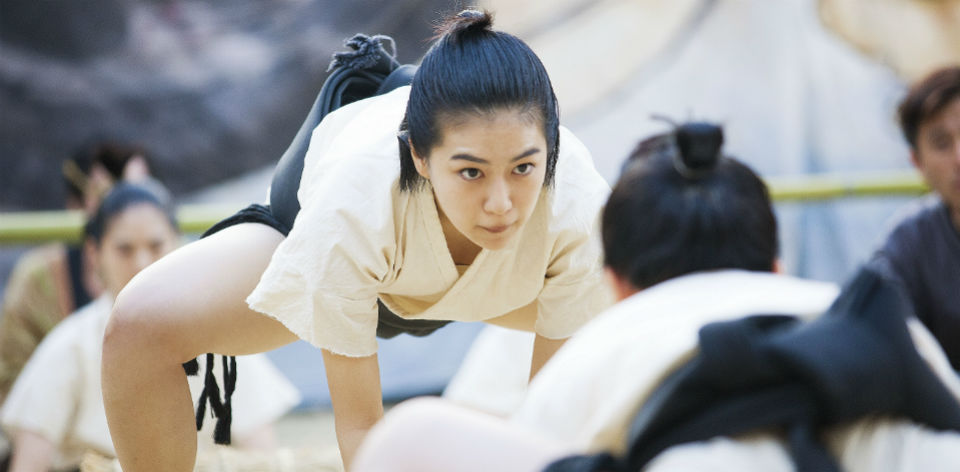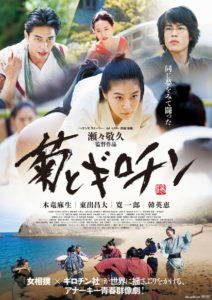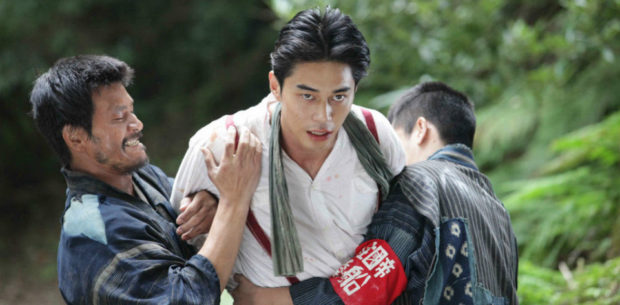Veteran filmmaker Takahisa Zeze is no stranger to stories of epic proportions. The former purveyor of erotic pinku films gained critical acclaim with Heaven’s Story (2010), a 278 minute film based on a true story. He’s also adapted 64, based on the Hideo Yokoyama novel, as a 2-part film that totals over 4 hours as well. THE CHRYSANTHEMUM AND THE GUILLOTINE (アントキノイノチ) might only clock in at a little over 3 hours, but it packs a hell of a lot of story into that frame.
Beginning with the Great Kanto Earthquake of 1923, the film is broadly about the social and political ramifications of the natural disaster and the rise of nationalism in its wake. More specifically, it follows a troupe of female sumo wrestlers whose number includes Kiku (Mai Kiryu) and Tamae (Hanae Kan), two women who are trying to escape the abuses of their past. Meanwhile, poet Tetsu (Masahiro Higashide) and Daijiro (Kanichiro) are members of the Guillotine Society, an anarchist group who are trying to stab, shoot, and explode their way to a better Japan. The storylines intersect when the Guillotine members start to watch the women’s wrestling matches.
Zeze’s third film in the last 12 months – following The 8-Year Engagement and My Friend ‘A’* – is perhaps one of his most ambitious. Yet it’s also a very packed film. Before the titles even drop, there’s a good 20 minutes of exposition just setting the scene in September 1923. Lots of characters are introduced rapidly, initially making it difficult to maintain a firm sense of place and character. Yet this is a sweeping summary of an era, and in that sense we do get a picture of the various factions, veterans, nationalists and rebels who changed Japan’s future.
The story is at its strongest when it is focusing on the sumo wrestlers, and the women who surround them. It’s unfortunate that Zeze is stylistically all over the place, rarely focusing on any one aspect for long. A violent stabbing encounter with the authorities is quickly followed by the Guillotine boys discussing venereal diseases and testicle hygiene. A variety of brutality is used by the veteran nationalists, including an incredibly tense forest scene in which several anarchists are forced to pledge their allegiance to the Emperor.
The primary story concludes around 1924 with the introduction of the US Immigration Act. The characters mark it as the point in which “the world began excluding the Japanese,” with Zeze’s film arguing that it was a significant cornerstone in the groundwork being laid for the Imperialism that followed. Title cards tell us the fate of the real-life counterparts of these characters, hammering home the very tangible end of an era represented here. Some have noted a similar current of nationalism spreading throughout the island nation in the wake of more recent natural disasters in Japan. Perhaps filmmakers of the year 2113 will have a 3-hour film showcasing that.
*Both are also playing at the Japanese Film Festival in 2018.
 2018 | Japan | DIR: Takahisa Zeze | WRITERS: Toranosuke Aizawa, Takahisa Zeze | CAST: Mai Kiryu, Hanae Kan, Masahiro Higashide, Kanichiro, Kanako Mochida | DISTRIBUTOR: Japanese Film Festival (AUS) | RUNNING TIME: 189 minutes | RELEASE DATE: October – December 2017 (JFF)
2018 | Japan | DIR: Takahisa Zeze | WRITERS: Toranosuke Aizawa, Takahisa Zeze | CAST: Mai Kiryu, Hanae Kan, Masahiro Higashide, Kanichiro, Kanako Mochida | DISTRIBUTOR: Japanese Film Festival (AUS) | RUNNING TIME: 189 minutes | RELEASE DATE: October – December 2017 (JFF)






